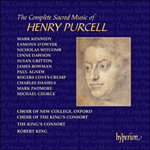According to the Gostling Manuscript, Blessed is the man that feareth the Lord was written to celebrate Founders Day at Charterhouse School, probably in 1688. This event usually took place on December 12th, with the service followed by a feast. In 1688 the preacher was John Patrick, the poet for at least nine of Purcell’s devotional songs. Scholars have suggested that Purcell may have composed the anthem earlier than 1688 with two solo parts, adapting it and adding a third soloist for the Charterhouse performance. We know that two of the soloists in 1688 were Mr Barincloe and the famous bass Mr Bowman. The anthem’s subsequent popularity ensured that it appeared in some twenty manuscripts which are spread all over Britain.
The opening is lyrical, with the word ‘great’ treated to a series of expansive melismas. The key and mood change at ‘His seed shall be mighty upon earth’: the harmony of ‘the generation of the faithful’ is especially rich as the bass singer takes an independent line from the continuo, creating a four-part texture. Triple metre returns at ‘Riches and plenteousness’ and Purcell sets ‘endureth for ever’ with a deliciously dropping motif which is anchored first over a pedal, and then an inverted pedal. A more Italianate section is introduced at ‘Unto the godly’ with a marvellous roulade for the high tenor on ‘ariseth’: ‘a good man’ is passed, almost conversationally, from voice to voice before the introduction of a more lively section, ‘his name shall be exalted with honour’. The solo alleluias begin simply but are gradually expanded and extended by Purcell. At least three different versions of the closing chorus are found in the various manuscript sources: we have used the version contained in the Durham and Liverpool manuscripts.
from notes by Robert King ©
Selon le manuscrit de Gostling,
Blessed is the man that feareth the Lord (‘Heureux l'homme qui craint le Seigneur’) fut écrit pour la célébration du Founders Day de l'école de Charterhouse, probablement en 1688. Cet événement avait lieu en principe le 12 décembre, et comprenait un office suivi d'un banquet. En 1688, le prédicateur fut le poète John Patrick, à qui l'on doit les textes d'au moins neuf chansons de dévotion de Purcell. Certains historiens avancent que Purcell pourrait avoir composé ce motet bien avant 1688 avec deux parties solistes, et qu'il l'aurait adapté en y greffant une troisième voix pour l'exécution de Charterhouse. On connaît deux des solistes de 1688: Barincloe et Bowman, la célèbre basse. Le succès du motet lui valut d'apparaître dans une vingtaine de manuscrits aujourd'hui disséminés à travers la Grande-Bretagne. L'oeuvre s'ouvre sur une introduction lyrique, le mot `great' donnant lieu à une série de longs mélismes. La tonalité et le caractère changent à ‘His seed shall be mighty upon earth’ (‘sa descendance sera puissante sur la terre’); l'harmonie de ‘the generation of the faithful’ (‘la génération des fidèles’) est particulièrement riche, la basse s'écartant du continuo pour créer une texture à quatre voix. La mesure à trois temps reprend sur ‘Riches and plenteousness’ (‘richesse et abondance’), et Purcell illustre ‘endureth for ever’ (‘subsiste à jamais’) avec un motif descendant s'appuyant tout d'abord sur une pédale puis sur une pédale renversée. ‘Unto the godly’ (‘sur l'homme pieux’) introduit une section au caractère plus italien, avec une merveilleuse roulade confiée au premier ténor sur le mot ‘ariseth’; ‘a good man’ passe d'une voix à l'autre, presque sur le ton de la conversation, avant l'introduction d'une nouvelle section à ‘His name shall be exalted with honour’ (‘son nom sera exalté avec gloire’). Les alléluias commencent sobrement mais se déploient progressivement. On trouve au moins trois versions différentes de la section chorale finale dans les divers manuscrits existants; nous utilisons ici la version contenue dans les manuscrits de Durham et de Liverpool.
extrait des notes rédigées par Robert King © 1994
Français: Jean-Paul Metzger
Dem Gostling-Manuskript nach zu schließen, entstand
Blessed is the man that feareth the Lord zur Feier des Gründertages der Charterhouse School wahrscheinlich im Jahre 1688. Diese Feier fand am 12. Dezember statt und der Abschluß der Feierlichkeiten war ein Bankett. 1688 predigte John Patrick, der Dichter von mindestens neun der Andachtslieder Purcells. In akademischen Kreisen wird vermutet, daß Purcell das Anthem schon vor 1688 mit zwei Solostimmen komponiert hatte und sie mit einer dritten Stimme für die Charterhouse-Feier ergänzte. Uns ist bekannt, daß zwei der Solisten von 1688 Mr Barincloe und der berühmte Baßsänger Mr Bowman waren: durch die darauffolgende Beliebtheit des Anthems wurde versichert, daß sie in über zwanzig Handschriften in ganz Großbritannien aufzufinden war. Die Einleitung ist lyrisch, das Wort ‘great’ [groß] mit ausladenden Melismen. Tonart und Stimmung ändern sich mit ‘His seed shall be mighty upon earth’ [Sein Stamm wird auf Erden mächtig]: die Harmonie von ‘the generation of the faithful’ [das Geschlecht der Frommen] ist besonders reichhaltig — der Baßsänger übernimmt von dem Continuo eine unabhängigige eigene Linie, womit eine vierteilige Struktur geschaffen wird. Der Tripeltakt kehrt bei ‘Riches and plenteousness’ [Reichtum und Fülle] wieder und Purcell vertont ‘endureth for ever’ [hat nimmer ein Ende] mit einem entzückend fallenden Motiv, das sich zuerst über einen Orgelpunkt und dann über einen umgekehrten Orgelpunkt zieht. Bei ‘Unto the godly’ [den Guten] wird ein italianisierterer Abschnitt mit einem wunderbaren Roller des hohen Tenors bei ‘arises’ [erhebt] eingeführt: ‘a good man’ [der Gerechte] wird fast wie im Gespräch von Stimme zu Stimme weitergeleitet, bevor sich ein lebhafterer Abschnitt ‘his name shall be exalted with honour’ [sein Name erhebt sich mit Ehre] vorstellt. Die Allelujas der Solostimmen beginnen einfach, werden aber allmählich breiter und ausladender. In verschiedenen Handschriftenquellen finden sich mindestens drei Versionen des Schlußchors: hier wurde die Version aus den Manuskripten von Durham und Liverpool verwendet.
aus dem Begleittext von Robert King © 1994


 Purcell: The Complete Sacred Music
Purcell: The Complete Sacred Music
